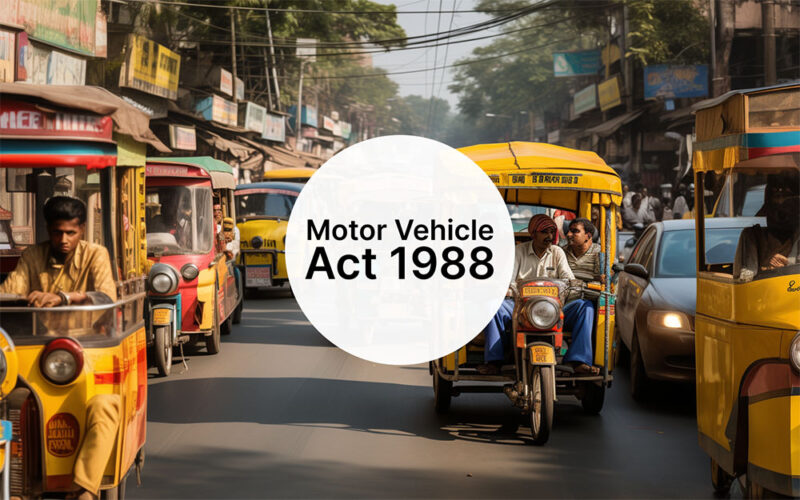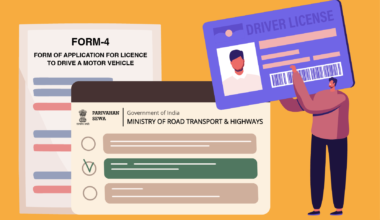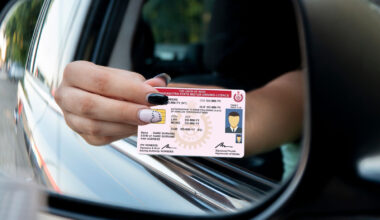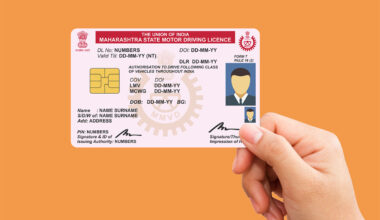The Motor Vehicles Act was introduced in 1988 to govern road vehicles and ensure that vehicle owners are obeying the rules and regulations. Further, the act was created to replace the Motor Vehicles Act of 1939.
Notably, the idea of the Motor Vehicles Act of 1988 was to ensure the implementation of a law that would accommodate the quickly changing vehicular technology and the demand for vehicles in India. It also left room for future improvements to allow lawmakers to bring new rules and regulations to ensure vehicle, passenger and pedestrian safety.
Read on to learn about the Motor Vehicles Act 1988 in detail.
What is the Motor Vehicles Act?
Indian Motor Vehicles Act contains all the rules and regulations related to road transport, traffic regulation, registration of motor vehicles, and permissions. Moreover, it includes provisions for vehicle insurance and other penalties.
But, the most crucial part of this new law is the implementation of Motor Vehicles Act Section 3 without fail. According to this section, anyone driving on Indian roads must have a driving licence. This act was finally imposed on July 1, 1989.
Moving on, in September 2019, the Indian Parliament introduced new amendments to the MV Act. It includes the following changes:
- Aadhaar card is compulsory for applying for a driver’s licence and vehicle registration.
- The penalty for drunk driving has been increased to Rs 10,000.
- The government will provide a reimbursement of Rs 2 lakh for the families of the hit-and-run victims.
- Legal guardians will be responsible if a minor drives under supervised or unsupervised conditions.
- The liability limit of the third party will be removed in case an individual passes away or incurs serious injury.
What are the Offences Covered Under the Motor Vehicles Act?
Different sections of the Motor Vehicles Act cover the following offences:
| Sections | Offence |
|---|---|
| 177 | General |
| New 177A | Breaching the rules of road regulation |
| 178 | Travelling without ticket |
| 179 | Not obeying the authorities’ orders |
| 180 | Using vehicles without licence |
| 181 | Driving without licence |
| 182 | Driving despite disqualification |
| 182 B | Using oversized vehicles |
| 183 | Over speeding |
| 184 | Dangerous driving |
| 185 | Drunken driving |
| 189 | Racing/speeding |
| 192 A | Using a vehicle without permission |
| 193 | Violations of licensing conditions |
| 194 | Overloading |
| 194 A | Overloading of passengers |
| 194 B | Not wearing a seat belt |
| 194 C | Overloading in two-wheelers |
| 194 D | Not wearing helmets |
| 194 E | Not providing the path for emergency vehicles |
| 196 | Driving without insurance |
| 199 | Juvenile offences |
| 206 | Power of officer to seize documents |
| 210 B | Offences committed by enforcement authorities |
Updated List of Traffic Fines for Different Violations in India
- Penalties for general offences in terms of Motor Vehicles Act:
| Violation | Penalty |
|---|---|
| Over speeding | Rs 1,000 for light motor vehicle and Rs 2,000 for medium motor vehicle |
| Drunk driving/driving with intoxicated items | Rs 10,000 and/or 6 months in prisonRs 15,000 and/or 2 years in prison, in case of repeating this violation |
| Overloaded with pillion riders | Rs 2,000 with the disqualification of licence and/or community service for 3 months |
| Driving without licence | Rs 5000 |
| Reckless driving | First offence: Rs 1,000 to Rs 5,000 and/or 6 months to 1 year in prison, licence seizure |
| Riding without helmet | Rs 1,000 and licence scrapping for 3 months |
| Driving without insurance | Rs 2,000 and/or 3 months in prison and community serviceRs 4,000 for repeating this violation |
| Signal jumping | Rs 1,000 to Rs 5,000 and/or 6 months to 1 year in prison, licence seizure |
| Juvenile driving | Rs 25,000 with 3 years in prison, don’t get licence until 25 years of age, and cancellation of vehicle registration for 1 year |
| Riding without permission | Up to Rs 10,000 and/or up to 6 months imprisonment |
| Driving without seatbelt | Rs 1,000 and/or community service |
| Talking on a phone or using it while driving | Rs 5,000 |
- Penalties for motor vehicles according to the MV Act:
| Violations | Penalties |
|---|---|
| Utilising the vehicle in a hazardous condition | Court challan |
| Not having a side mirror | Rs 100 |
| For not printing the particulars on transport vehicles | Rs 100 |
| Using defected tyres | Rs 100 |
| A vehicle is out of state for more than 1 year | Rs 100 |
| Not having a wiper | Rs 100 |
| No indication board for driving vehicles on the left side | Rs 100 |
| Driving without a valid number plate | Rs 100 |
| Vehicles with dark glasses/sun films/tint | Rs 100 |
| Using private automobiles for business | Between Rs 2,000 and Rs 5,000 |
| Modifying or selling a motor vehicle according to the contravention of act | Rs 300 |
| Not showing a public carrier board | Rs 100 |
| Using coloured/tinted light on the vehicle | Rs 100 |
| Loading goods more than the allowed weight | Rs 20,000 and Rs 2,000 for every additional ton |
| Breaking of terms and conditions | Imprisonment and/or penalty of Rs 2,000 to Rs 5,000 |
| Transporting goods in a dangerous way | Imprisonment and/or penalty of Rs 3,000 |
| Misbehaviour with commuters, not wearing the uniform/not showing the badge | Rs 100 |
| Overloading of passengers | Rs 1,000 per extra passenger |
| Not providing way for emergency vehicles | Rs 10,000 |
| Power of officer on impounding documents | Suspension of licences under the sections of 183, 184, 185, 189, 190, 194C, 194D, 194E |
| Offences committed by the enforcement authorities | Twice penalty under the associated section |
| Travelling without ticket | Rs 500 |
| Breaching the rules of road regulation | Rs 500 |
| Racing/speeding | Rs 5,000 |
Read more: A Guide to Vehicle Number Plates: Components, Types, and Regulations
The Motor Vehicles Act 1988 covers all the rules, regulations, and penalties for the road transport system in India. However, the government introduced some radical changes in the act through the amendment of 2019. The new act is encompassing more firm rules and penalties. So, it goes without saying that it’s compulsory for all persons to comply with these norms to ensure their and fellow citizens’ safety and enjoy driving.










